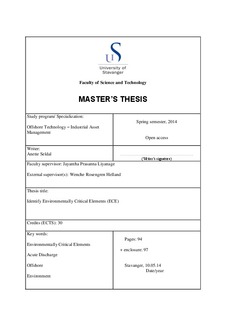| dc.contributor.author | Seldal, Anette | |
| dc.date.accessioned | 2014-09-16T10:52:04Z | |
| dc.date.available | 2014-09-16T10:52:04Z | |
| dc.date.issued | 2014-06-10 | |
| dc.identifier.uri | http://hdl.handle.net/11250/219872 | |
| dc.description | Master's thesis in Offshore technology : industrial asset management | nb_NO |
| dc.description.abstract | This study is based on information from internal GDF SUEZ E&P Norge AS (GDF SUEZ) documents. This includes system books, P&ID’s and external journals regarding Environmentally Critical Elements (ECE). The scope of the thesis is to research parts of the Gjøa offshore installation and identify if there are any environmentally critical elements that have been overlooked during the identification of safety critical elements. To reduce the risk of acute discharge to sea the equipment/tags that are identified will be listed into a checklist. The checklist system will be as similar as possible to the already existing safety critical elements (HSE). The checklist will contain the classified criticality of production, HSE (safety) and the environment to compare them with each other.
There are four system that have been analyzed to find ECEs.
System 44, Produced Water: In this system there were identified six Environmentally Critical Elements. When comparing the criticality for production, HSE (safety) it was clear that the environment was not represented and there was given a new criticality for the identified ECEs in relation to the environment.
System 56, Open Drain: in this system there were identified four Environmentally Critical Elements. In this system when comparing the criticality between production, safety and environment two of the four ECEs had the same criticality for safety and environment.
System 38, MEG Regeneration: in this system there were identified ten Environmentally Critical Elements. In this system the classified criticality for HSE (safety) had excluded the environment and just based the criticality on safety. All the then ECEs got a new criticality based on the environment.
System 65, Hydraulic: in this system there were identified eight Environment Critical Elements. When comparing the criticality for production, HSE (safety) and environment it was clear that the environment was left out of the classification of the criticality. | nb_NO |
| dc.language.iso | eng | nb_NO |
| dc.publisher | University of Stavanger, Norway | nb_NO |
| dc.relation.ispartofseries | Masteroppgave/UIS-TN-IKM/2014; | |
| dc.rights | Attribution-NonCommercial-NoDerivs 3.0 Norway | * |
| dc.rights.uri | http://creativecommons.org/licenses/by-nc-nd/3.0/no/ | * |
| dc.subject | offshore teknologi | nb_NO |
| dc.subject | driftledelse | nb_NO |
| dc.subject | environmentally critical elements | nb_NO |
| dc.title | Identify environmentally critical elements (ECE) | nb_NO |
| dc.type | Master thesis | nb_NO |
| dc.subject.nsi | VDP::Technology: 500::Marine technology: 580::Offshore technology: 581 | nb_NO |

